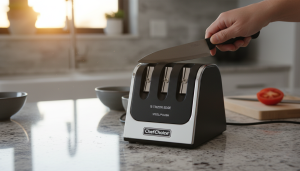Best Home Knife Sharpener – My Honest Review & Top Picks
There’s something oddly satisfying about slicing through a tomato with a perfectly sharp knife — no squishing, no sawing, just that clean, smooth cut. But if you’ve ever struggled with dull blades, you know the frustration.
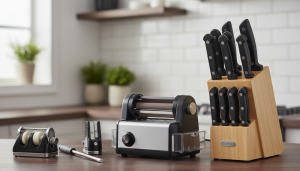
After years of testing different knife sharpeners, from budget handheld gadgets to high-end electric ones, I’ve discovered that not all of them deliver what they promise. Some are too aggressive and grind away your blades; others barely make a difference.
In this guide, I’ll share my honest experiences with the best sharpeners for home kitchens, what to look for when buying one, and which models are worth the counter space.
What You’ll Learn in This Guide
-
What makes a good home knife sharpener
-
The difference between manual and electric sharpeners
-
My top tested picks (and why they work)
-
Tips for sharpening safely and efficiently
-
When to sharpen vs. when to hone
-
Maintenance and care hacks for your blades
Quick Comparison: My Favorite Knife Sharpeners
| Sharpener | Type | Best For | Key Features |
|---|---|---|---|
| Chef’sChoice Trizor XV | Electric | Best Overall | Converts knives to 15° edge, durable motor |
| Work Sharp Knife & Tool Sharpener MK2 | Electric | Heavy-Duty Use | Belt system, variable speed |
| Wüsthof Precision Edge 4-Stage | Manual | Everyday Home Use | Compact, non-slip base, multi-stage sharpening |
| KitchenIQ Edge Grip | Manual | Budget Pick | Simple, portable, two-stage sharpening |
| PriorityChef Sharpener | Manual | Quick Touch-ups | Easy to use, ergonomic design |
(If you’re still building your knife collection, check out my Best Kitchen Knife Set guide — because even the best sharpener can’t save a poor-quality blade.)
How I Judge a Good Knife Sharpener
Before I even start sharpening, I look for three essential things: precision, control, and blade safety. A good sharpener should restore the edge without removing too much metal.
1. Sharpening Angle
The angle determines how sharp and durable your knife edge will be. Most Western knives use a 20° edge, while Japanese knives are around 15°. A flexible sharpener should handle both.
2. Abrasive Material
Diamond abrasives cut quickly and last longest. Ceramic rods are gentle and perfect for fine honing. Carbide blades remove material fast but can be too harsh for premium knives.
3. Ease of Use
If a sharpener feels awkward, you won’t use it often — and dull knives are dangerous knives. Comfort, grip, and balance all matter, especially for beginners.
4. Maintenance
Some electric models have removable covers for easy cleaning. Manual ones just need a quick wipe-down after use. I prefer tools that don’t require special oil or maintenance kits.
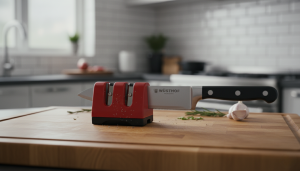
My Top Picks for Home Knife Sharpeners
1. Chef’sChoice Trizor XV – Best Overall Electric Sharpener
If there’s one sharpener I recommend to anyone serious about cooking, it’s the Chef’sChoice Trizor XV. It’s powerful, consistent, and honestly foolproof.
This machine converts traditional 20° knives into a sharper 15° edge — giving them that precise, almost Japanese-style performance.
The three-stage sharpening system includes diamond abrasives and a flexible stropping stage that polishes the edge perfectly. It’s fast, quiet, and surprisingly compact for its power.
Ideal for: Home chefs who want professional-level sharpness without the learning curve.
(For reference, I use this sharpener with the blades from my favorite knife set, and it keeps them like new.)
2. Work Sharp Knife &
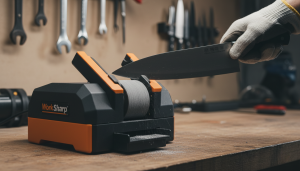
Tool Sharpener MK2 – Best for Heavy-Duty Use
If you like a more hands-on, workshop-style approach, this one’s a beast. The Work Sharp MK2 uses a belt-driven system, like a mini knife workshop on your countertop.
It lets you control the sharpening angle (15°–30°), and the variable speed motor gives flexibility for delicate or tough blades.
It’s perfect for kitchen knives, hunting knives, and even scissors — so it’s more of an all-rounder tool sharpener than a single-purpose device.
Ideal for: Home cooks who also handle outdoor tools or hunting knives.
Outbound Link: The manufacturer’s official Work Sharp site provides detailed user guides and replacement belts.
3. Wüsthof Precision Edge 4-Stage – Best Manual Sharpener
Compact, lightweight, and reliable — the Wüsthof Precision Edge is my favorite manual pick.
It includes two stages for standard blades and two for Asian-style knives, covering every type of edge I own. The non-slip rubber base keeps it steady, and the handle is comfortable for both left and right-handed users.
I like using this one for quick weekly touch-ups. It doesn’t over-sharpen — it simply maintains that fine edge between full sharpening sessions.
Ideal for: Everyday home cooks who want quick and easy control.
4. KitchenIQ Edge Grip – Best Budget-Friendly Sharpener
Don’t underestimate this little guy. The KitchenIQ Edge Grip is small enough to fit in a drawer, yet effective enough for quick sharpening before dinner prep.
It features coarse and fine slots, ideal for basic sharpening and polishing. I often keep one near my prep area for quick touch-ups between bigger cooking days.
Plus, the “edge grip” design means you can safely rest it on a countertop edge without scratching surfaces — a nice touch for small kitchens.
Ideal for: Students, renters, or anyone on a tight budget.
5. PriorityChef 2-Stage Sharpener – Best for Quick Touch-Ups
Simple, sleek, and ergonomic — the PriorityChef 2-Stage Sharpener is perfect for quick edge refreshes.
It uses diamond and ceramic wheels for a two-stage process that sharpens and then refines the blade. It’s easy to grip and lightweight, so it’s great for anyone who doesn’t want to fuss with electric tools.
I’ve used it for years as my “weeknight helper” — when I don’t have time for a full sharpening session but still want a clean slice through onions.
Ideal for: Busy home cooks or those new to knife care.
Manual vs. Electric: Which Should You Choose?
If you’re unsure which type to get, here’s my quick take:
-
Manual sharpeners are cheaper, quieter, and easier to store. Ideal for light use or smaller kitchens.
-
Electric sharpeners give precise, consistent edges faster — great for large knife sets or frequent use.
Personally, I keep one of each: my Chef’sChoice Trizor XV for deep sharpening, and a Wüsthof manual for weekly maintenance.
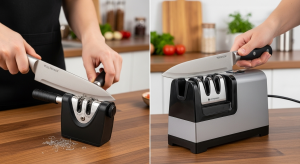
How Often Should You Sharpen Your Knives?
It depends on how often you cook.
-
Daily cooks: Every 2–3 months
-
Casual users: Twice a year
-
Professional chefs: Every few weeks
You can hone in between sharpening sessions using a honing rod to maintain the edge. A good sharpening rhythm keeps your knives efficient and extends their lifespan.
Sharpening Tips I’ve Learned Over Time
After years of dull blades and trial-and-error, here’s what I know works:
1. Don’t Press Too Hard
Let the sharpener do the work. Too much pressure can damage the edge or remove excess steel.
2. Clean Knives Before Sharpening
Always start with dry, clean blades — residue dulls abrasives faster.
3. Wipe Blades After Sharpening
Metal shavings can linger, so wipe with a damp cloth before using your knife again.
4. Alternate Between Coarse and Fine Slots
Always finish on the fine side — that’s where the smooth, polished edge comes from.
5. Store Knives Properly
Use a knife block or magnetic strip — not a drawer. Sharp blades deserve better than clattering around with spoons.
Maintenance & Cleaning Tips
Sharpeners, especially electric ones, collect fine metal dust. Here’s what I do:
-
Tap gently over a trash bin after each use.
-
Wipe surfaces with a soft cloth.
-
Avoid water near the motor (for electric types).
-
Replace belts or discs when they start losing grit.
For a complete kitchen care setup, you can explore my post on maintaining your kitchen knife set. A sharp blade and a solid handle always go hand in hand.
Common Mistakes to Avoid
-
Sharpening too often: It wears down blades faster.
-
Using wrong angles: Not all knives are the same — check your knife’s recommended edge angle.
-
Ignoring honing: Sharpening fixes dullness; honing maintains sharpness. Both matter.
-
Overheating: On electric sharpeners, go slow to avoid friction heat.
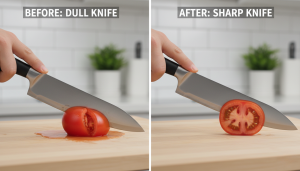
FAQs I Get About Knife Sharpeners
Do electric sharpeners damage knives?
Not if used correctly. High-quality electric sharpeners like Chef’sChoice control friction and angle precisely.
Can I sharpen serrated knives?
Some sharpeners have a serrated slot (like the Wüsthof model). Otherwise, use a ceramic honing rod for serrated edges.
How do I know when my knife needs sharpening?
If it slips off a tomato or can’t cut paper cleanly, it’s time.
Are whetstones better than sharpeners?
Whetstones allow ultimate control but require skill. Sharpeners are faster and easier for most home cooks.
My Final Thoughts
A good knife sharpener is like an insurance policy for your kitchen tools — it protects your investment and keeps your cooking smooth.
If you want precision and power, go with the Chef’sChoice Trizor XV. For manual control, the Wüsthof Precision Edge is unbeatable. And if you just want something quick and easy, the KitchenIQ Edge Grip delivers great value for its size.
Whatever you choose, remember: a sharp knife isn’t just satisfying — it’s safer, cleaner, and makes cooking genuinely enjoyable.
(For more gear advice, check my Best Kitchen Knife Set guide — because even the sharpest knife needs the right companion in your kitchen.)
